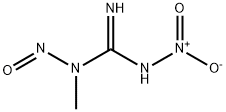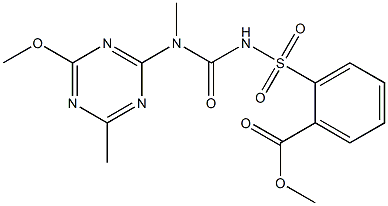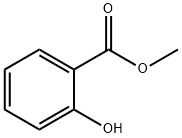1-Methyl-3-nitro-1-nitrosoguanidine
- CAS NO.:70-25-7
- Empirical Formula: C2H5N5O3
- Molecular Weight: 147.09
- MDL number: MFCD00007034
- EINECS: 200-730-1
- SAFETY DATA SHEET (SDS)
- Update Date: 2023-06-08 17:06:36

What is 1-Methyl-3-nitro-1-nitrosoguanidine?
Chemical properties
yellow to pink crystals
The Uses of 1-Methyl-3-nitro-1-nitrosoguanidine
A DNA-damaging agent, used as a positive control in SHE cell transformation assays.
The Uses of 1-Methyl-3-nitro-1-nitrosoguanidine
Experimentally as carcinogen and mutagen. Formerly in preparation of diazomethane.
Definition
ChEBI: An N-nitroguanidine compound having nitroso and methyl substituents at the N'-position
Production Methods
MNNG is one of the first chemical mutagens and is a stabilized form of methylnitrosoguanidine, which has not been isolated. It does not occur in nature, and human exposure to it is limited to laboratories.
General Description
A yellow powder. Melting point 244°F. Decomposes above 212°F. A suspected carcinogen. Extremely hazardous as a mutagen. Avoid skin contact and inhalation of of vapors. Usually stored frozen (below 32°F) in polyethylene bottles that are tightly closed and contained in a metal can. May decomposed during prolonged storage and develop sufficient pressure in a closed container to explode. Keep away from heat, sparks, and open flame.
Air & Water Reactions
Highly flammable. Reacts violently with water .
Reactivity Profile
1-Methyl-3-nitro-1-nitrosoguanidine will detonate under high impact. 1-Methyl-3-nitro-1-nitrosoguanidine is sensitive to heat. A sample has exploded when melted in a sealed capillary tube. Incompatible with acids, bases, oxidizing agents and reducing agents. Reacts with bases to release highly toxic, irritating and explosive gases. Reacts slowly with acids to release nitrous acid. Reacts with various nucleophiles, especially amines and thiols. Reacts with aqueous potassium hydroxide to form a highly reactive compound. The crude product from aqueous nitrosation is pyrophoric but recrystallized material is stable .
Health Hazard
Fire may produce irritating and/or toxic gases. Contact may cause burns to skin and eyes. Contact with molten substance may cause severe burns to skin and eyes. Runoff from fire control may cause pollution.
Fire Hazard
Flammable/combustible material. May be ignited by friction, heat, sparks or flames. Some may burn rapidly with flare burning effect. Powders, dusts, shavings, borings, turnings or cuttings may explode or burn with explosive violence. Substance may be transported in a molten form at a temperature that may be above its flash point. May re-ignite after fire is extinguished.
Safety Profile
Confirmed carcinogen with experimental carcinogenic, tumorigenic, and teratogenic data. Poison by ingestion, intraperitoneal, and intravenous routes. Moderately toxic by subcutaneous route. Experimental reproductive effects. Human mutation data reported. An explosive sensitive to heat or impact. Flammable when exposed to heat or flame; can react vigorously with oxidizing materials. When heated to decomposition it emits very toxic fumes of NOx.
Carcinogenicity
N-Methyl-N-nitro-N-nitrosoguanidine (MNNG) is reasonably anticipated to be a human carcinogen based on sufficient evidence of carcinogenicity from studies in experimental animals.
Properties of 1-Methyl-3-nitro-1-nitrosoguanidine
| Melting point: | 118°C (dec.) |
| Boiling point: | 267.16°C (rough estimate) |
| Density | 1.7979 (rough estimate) |
| refractive index | 1.6410 (estimate) |
| storage temp. | 0-6°C
|
| solubility | almost transparency in hot Methanol |
| form | powder to crystal |
| pka | 3.09±0.50(Predicted) |
| color | Light yellow to Brown |
| Water Solubility | Reacts violently |
| Merck | 14,6103 |
| Stability: | Unstable. Reacts violently with water. May detonate under impact. Heat, light and moisture sensitive. May explode if stored in sealed ampules. Highly flammable. Incompatible with aqueous solutions, acids, bases, oxidizing agents, reducing agents. Alkaline hydrolysis releases toxic and explosive gases. |
| CAS DataBase Reference | 70-25-7(CAS DataBase Reference) |
| NIST Chemistry Reference | Guanidine, n-methyl-n'-nitro-n-nitroso-(70-25-7) |
| IARC | 2A (Vol. 4, Sup 7) 1987 |
| EPA Substance Registry System | N-Methyl-N'-nitro-N-nitrosoguanidine (70-25-7) |
Safety information for 1-Methyl-3-nitro-1-nitrosoguanidine
| Signal word | Danger |
| Pictogram(s) |
 Flame Flammables GHS02  Skull and Crossbones Acute Toxicity GHS06  Exclamation Mark Irritant GHS07  Health Hazard GHS08  Environment GHS09 |
| GHS Hazard Statements |
H228:Flammable solids H301:Acute toxicity,oral H315:Skin corrosion/irritation H319:Serious eye damage/eye irritation H332:Acute toxicity,inhalation H350:Carcinogenicity H411:Hazardous to the aquatic environment, long-term hazard |
| Precautionary Statement Codes |
P201:Obtain special instructions before use. P202:Do not handle until all safety precautions have been read and understood. P210:Keep away from heat/sparks/open flames/hot surfaces. — No smoking. P240:Ground/bond container and receiving equipment. P241:Use explosion-proof electrical/ventilating/lighting/…/equipment. P261:Avoid breathing dust/fume/gas/mist/vapours/spray. P264:Wash hands thoroughly after handling. P264:Wash skin thouroughly after handling. P270:Do not eat, drink or smoke when using this product. P271:Use only outdoors or in a well-ventilated area. P273:Avoid release to the environment. P280:Wear protective gloves/protective clothing/eye protection/face protection. P391:Collect spillage. Hazardous to the aquatic environment P308+P313:IF exposed or concerned: Get medical advice/attention. P405:Store locked up. P501:Dispose of contents/container to..… |
Computed Descriptors for 1-Methyl-3-nitro-1-nitrosoguanidine
| InChIKey | VZUNGTLZRAYYDE-UHFFFAOYSA-N |
New Products
4-AMINO-TETRAHYDRO-PYRAN-4-CARBOXYLIC ACID HCL 4-(Dimethylamino)tetrahydro-2H-pyran-4-carbonitrile 4-Aminotetrahydropyran-4-carbonitrile Hydrochloride (R)-3-Aminobutanenitrile Hydrochloride 3-((Dimethylamino)methyl)-5-methylhexan-2-one oxalate 1,4-Dioxa-8-azaspiro[4.5]decane 5-Bromo-2-nitropyridine Nimesulide BP Aceclofenac IP/BP/EP Diclofenac Sodium IP/BP/EP/USP Mefenamic Acid IP/BP/EP/USP Ornidazole IP Diclofenac Potassium THOMAIND PAPER PH 2.0 TO 4.5 1 BOX BUFFER CAPSULE PH 9.2 - 10 CAP SODIUM CHLORIDE 0.1N CVS ALLOXAN MONOHYDRATE 98% PLATINUM 0.5% ON 3 MM ALUMINA PELLETS (TYPE 73) LITHIUM AAS SOLUTION 2-Bromo-1-(bromomethyl)-3-chloro-5-nitrobenzene 2-Bromo-3-nitroaniline N-(3-Hydroxypropyl)-N-methylacetamide 3-Bromo-6-chloropyridazine 4-ethyl-3-nitrobenzoic acidRelated products of tetrahydrofuran








You may like
-
 1-Methyl-6-oxo-1,6-dihydropyridazine-3-carbonitrile 98%View Details
1-Methyl-6-oxo-1,6-dihydropyridazine-3-carbonitrile 98%View Details
99903-60-3 -
 88491-46-7 98%View Details
88491-46-7 98%View Details
88491-46-7 -
 1823368-42-8 98%View Details
1823368-42-8 98%View Details
1823368-42-8 -
 2-(3-(tert-butyl)phenoxy)-2-methylpropanoic acid 1307449-08-6 98%View Details
2-(3-(tert-butyl)phenoxy)-2-methylpropanoic acid 1307449-08-6 98%View Details
1307449-08-6 -
 Ethyl 3-(furan-2-yl)-3-hydroxypropanoate 25408-95-1 98%View Details
Ethyl 3-(furan-2-yl)-3-hydroxypropanoate 25408-95-1 98%View Details
25408-95-1 -
 2-Chloro-5-fluoro-1-methoxy-3-methylbenzene 98%View Details
2-Chloro-5-fluoro-1-methoxy-3-methylbenzene 98%View Details
1805639-70-6 -
 1784294-80-9 98%View Details
1784294-80-9 98%View Details
1784294-80-9 -
 Lithium ClavulanateView Details
Lithium ClavulanateView Details
61177-44-4